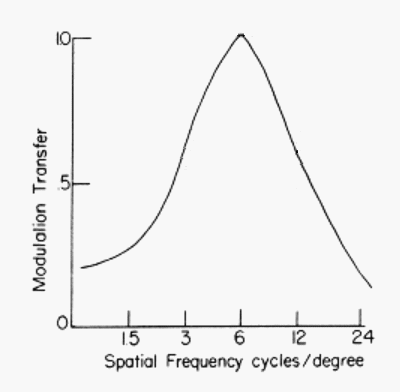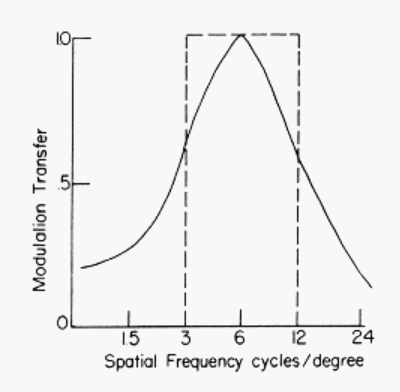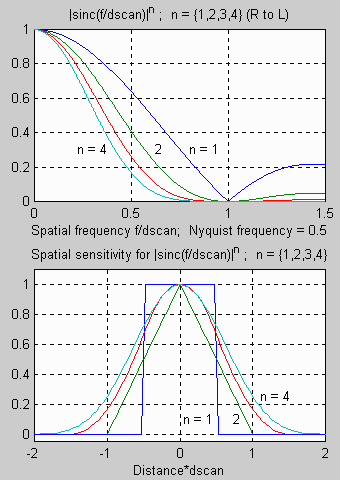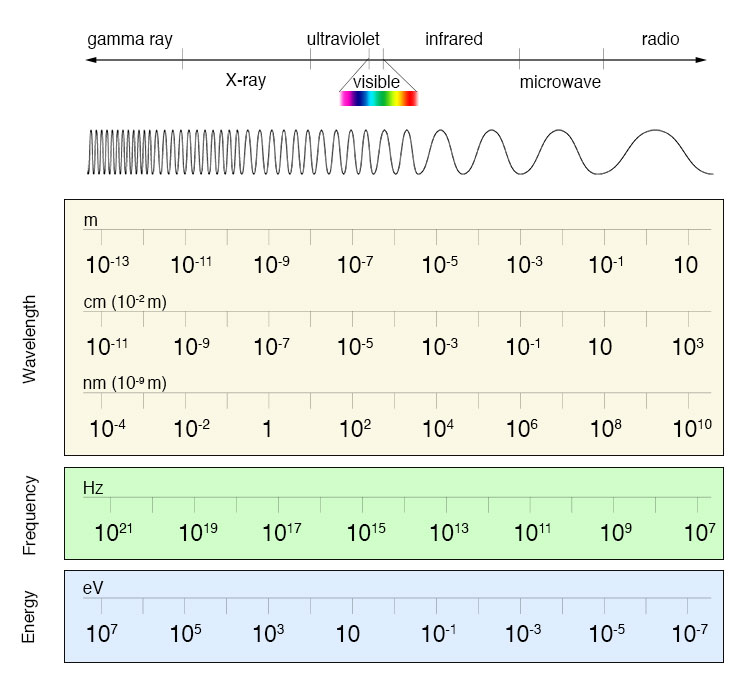Doug Kerr
Well-known member
I continue to be fascinated by a single-valued metric for the overall "sharpness" of an image, as it will be perceived perceived by a human viewer, called the Subjective Quality Factor (SQF).
To understand the principle of this metric, we need to recognize that the human visual system has a differing sensitivity to contrast at different angular frequencies (for the moment, consider these to be essentially like spatial frequencies). The recognized curve of this variation (for typical human viewers) is called the Contrast Sensitivity Function (CSF). It is essentially the MTF of the human visual system (not just to the optical image on the retina, but beyond, to the "perception" of that image).
To reckon the SQF of an imaging system (lets say of a camera), we take the MTF of the system (to the digital output) and multiply it at each spatial frequency by the value of the CSF at that frequency. We can crudely think of this as the MTF of the entire system, through to the human perception of the image. Or we can think of it as the MTF of the system weighted by the eye's varying sensitivity to contrast at each spatial frequency.
We then take the area under this "end-to-end MTF" curve. That (appropriately scaled) is the SQF of the camera.
But there is of course a complication. The MTF of the camera is based on spatial frequency (for example, at the focal plane, or if we wish, as projected onto a print or display image of some arbitrary size) whereas the CSF is in angular frequency terms.
Thus, to make the determination of SQF, we must contemplate some particular sized image in angular terms; that is, some particular image size to be viewed from some particular distance. Then there is a relationship between spatial frequency at the focal plane and angular frequency to the eye.
Of course, we may say, "well, we are trying to get a metric of how well the camera does, so we should not have to contemplate a particular viewing situation".
But, like it or not, if we decide to judge the camera based on how well does it do for the human eye, we have no choice but to contemplate the context in which the human eye will receive the image.
There is no doubt that this troublesome wrinkle is in part responsible for the limited interest in the SQF metric. We want a numerical answer to the question "how good was Marilyn Monroe", without the burden of considering, "at what?").
I would be interested to hear of any experience other members have had with considering the SQF ratings of cameras and whether they useful in predicting performance as adjudged by viewers.
Best regards,
Doug
There is a closely-related metric called acutance (a word that essentially means "sharpness").
This metric is reported by some testing "agencies" in their reviews of cameras.To understand the principle of this metric, we need to recognize that the human visual system has a differing sensitivity to contrast at different angular frequencies (for the moment, consider these to be essentially like spatial frequencies). The recognized curve of this variation (for typical human viewers) is called the Contrast Sensitivity Function (CSF). It is essentially the MTF of the human visual system (not just to the optical image on the retina, but beyond, to the "perception" of that image).
To reckon the SQF of an imaging system (lets say of a camera), we take the MTF of the system (to the digital output) and multiply it at each spatial frequency by the value of the CSF at that frequency. We can crudely think of this as the MTF of the entire system, through to the human perception of the image. Or we can think of it as the MTF of the system weighted by the eye's varying sensitivity to contrast at each spatial frequency.
We then take the area under this "end-to-end MTF" curve. That (appropriately scaled) is the SQF of the camera.
But there is of course a complication. The MTF of the camera is based on spatial frequency (for example, at the focal plane, or if we wish, as projected onto a print or display image of some arbitrary size) whereas the CSF is in angular frequency terms.
Thus, to make the determination of SQF, we must contemplate some particular sized image in angular terms; that is, some particular image size to be viewed from some particular distance. Then there is a relationship between spatial frequency at the focal plane and angular frequency to the eye.
Of course, we may say, "well, we are trying to get a metric of how well the camera does, so we should not have to contemplate a particular viewing situation".
But, like it or not, if we decide to judge the camera based on how well does it do for the human eye, we have no choice but to contemplate the context in which the human eye will receive the image.
There is no doubt that this troublesome wrinkle is in part responsible for the limited interest in the SQF metric. We want a numerical answer to the question "how good was Marilyn Monroe", without the burden of considering, "at what?").
I would be interested to hear of any experience other members have had with considering the SQF ratings of cameras and whether they useful in predicting performance as adjudged by viewers.
Best regards,
Doug




